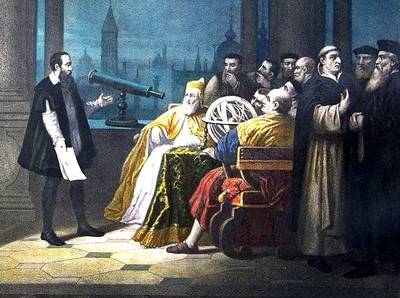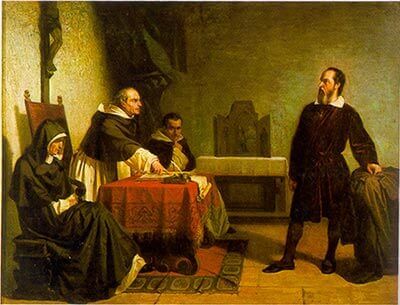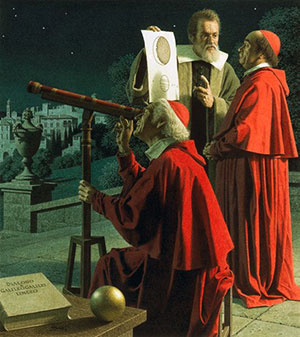| Galileo and Truth | |||||||||
The case of Galileo is quite instructive.
|
|||||||||
THE GALILEO AFFAIR The pope refusing to look though Galileo’s telescope at the moons of Jupiter is an icon of humanism: science v religion (or ‘blind’ faith). The pope declined to view evidence that not everything in the universe revolves around the earth. Yet, from a Biblically based Hebraic perspective the moral of the story is turned upside down or, rather, put right-side up. Why wouldn’t the pope look? Galileo developed the ideas of Copernicus about the solar system, with the cautious backing of cardinal Barberini. But, Galileo fell afoul of Vatican politics and lost Barberini as an ally after he became pope Urban VIII. This is the pope who declined to look through the telescope and forced Galileo to recant his claims. Who Refused to Look through Galileo's Telescope? There are three pieces of evidence that have gone into the construction of the legend, as far as we can tell. The first concerns Cesare Cremonini, a good friend of Galileo and a Professor of Aristotelian Philosophy at the University of Padua. Quoted in a letter from a mutual friend to Galileo, Cremonini says of the telescope. It's clear that Cremonini did look through the telescope long enough to give himself a headache but could not see what Galileo could. Frankly, it was more than Cremonini's job was worth to endorse Galileo because it would have refuted Aristotle. Philosophers who refused to look through Galileo's Telescope Galileo Galilei, like Kepler, was a mathematicus, (a term used for a mathematician, astrologer and astronomer). Galileo complained to Kepler that some of the philosophers who opposed his discoveries had refused even to look through his telescope. My dear Kepler, I wish that we might laugh at the remarkable stupidity of the common herd. What do you have to say about the principal philosophers of this academy who are filled with the stubbornness of an asp and do not want to look at either the planets, the moon or the telescope, even though I have freely and deliberately offered them the opportunity a thousand times? Truly, just as the asp stops its ears, so do these philosophers shut their eyes to the light of truth. Who were the most likely philosophers? Cesare Cremonini, [1550 – 1631] was a friend and rival of his colleague Galileo Galilei at the University of Padua, Italy. When Galileo announced he had seen mountains on the Moon, Cremonini and others denounced the claim but refused to look through Galileo’s telescope. The evidence would have refuted Aristotle’s theory that the Moon was a perfect sphere and made his position as Professor of Aristotelian Philosophy at the University, untenable. Cremonini was later quoted as saying “I do not wish to approve of claims about which I do not have any knowledge, and about things which I have not seen … and then to observe through those glasses gives me a headache. Enough! I do not want to hear anything more about this." I would understand his concern for his eyes when it comes to the observation of Sunspots, but not with the Moon. Either way, it sounds like an excuse to avoid seeing the evidence that would challenge his world-view. Galileo affair, From Wikipedia, the free encyclopedia In 1610, Galileo published his Sidereus Nuncius (Starry Messenger), describing the surprising observations that he had made with the new telescope, namely the phases of Venus and the Galilean moons of Jupiter. With these observations he promoted the heliocentric theory of Nicolaus Copernicus (published in De revolutionibus orbium coelestium in 1543). Galileo's initial discoveries were met with opposition within the Catholic Church, and in 1616 the Inquisition declared heliocentrism to be formally heretical. Heliocentric books were banned and Galileo was ordered to refrain from holding, teaching or defending heliocentric ideas. Galileo went on to propose a theory of tides in 1616, and of comets in 1619; he argued that the tides were evidence for the motion of the Earth. In 1632 Galileo, now an old man, published his Dialogue Concerning the Two Chief World Systems, which implicitly defended heliocentrism, and was immensely popular. Responding to mounting controversy over theology, astronomy and philosophy, the Roman Inquisition tried Galileo in 1633 and found him "gravely suspect of heresy", sentencing him to indefinite imprisonment. Galileo was kept under house arrest until his death in 1642. Robert Cardinal Bellarmine, one of the most respected Catholic theologians of the time, was called on to adjudicate the dispute between Galileo and his opponents, who included both religious and secular university professors. Bellarmine found no problem with heliocentrism so long as it was treated as a purely hypothetical calculating device and not as a physically real phenomenon, but he did not regard it as permissible to advocate the latter unless it could be conclusively proved through current scientific standards. This put Galileo in a difficult position, because he believed that the available evidence strongly favored heliocentrism, and he wished to be able to publish his arguments. Sentence On February 24 the Qualifiers delivered their unanimous report: the idea that the Sun is stationary is "foolish and absurd in philosophy, and formally heretical since it explicitly contradicts in many places the sense of Holy Scripture..."; while the Earth's movement "receives the same judgement in philosophy and ... in regard to theological truth it is at least erroneous in faith." The original report document was made widely available in 2014. At a meeting of the cardinals of the Inquisition on the following day, Pope Paul V instructed Bellarmine to deliver this result to Galileo, and to order him to abandon the Copernican opinions; should Galileo resist the decree, stronger action would be taken. On February 26, Galileo was called to Bellarmine's residence and ordered, to abstain completely from teaching or defending this doctrine and opinion or from discussing it... to abandon completely... the opinion that the sun stands still at the center of the world and the earth moves, and henceforth not to hold, teach, or defend it in any way whatever, either orally or in writing. -The Inquisition's injunction against Galileo, 1616. In the end, Galileo did not persuade the Church to stay out of the controversy, but instead saw heliocentrism formally declared false. It was consequently termed heretical by the Qualifiers, since it contradicted the literal meaning of the Scriptures, though this position was not binding on the Church. Dialogue Concerning the Two Chief World Systems
In 1623, Pope Gregory XV, died, and was succeeded by Pope Urban VIII, who showed greater favor to Galileo, particularly after Galileo traveled to Rome to congratulate the new Pontiff. Galileo's Dialogue Concerning the Two Chief World Systems, which was published in 1632 to great popularity, was an account of conversations between a Copernican scientist, Salviati, an impartial and witty scholar named Sagredo, and a ponderous Aristotelian named Simplicio, who employed stock arguments in support of geocentricity, and was depicted in the book as being an intellectually inept fool. Cristiano Banti's 1857 painting Galileo facing the Roman Inquisition With the loss of many of his defenders in Rome because of Dialogue Concerning the Two Chief World Systems, Galileo was ordered to stand trial on suspicion of heresy in 1633, "for holding as true the false doctrine taught by some that the sun is the center of the world". Galileo was found guilty, and the sentence of the Inquisition, was issued on 22 June 1633. Galileo was found "vehemently suspect of heresy," namely of having held the opinions that the Sun lies motionless at the center of the universe, that the Earth is not at its centre and moves, and that one may hold and defend an opinion as probable after it has been declared contrary to Holy Scripture. He was required to "abjure, curse, and detest" those opinions. According to popular legend, after his abjuration Galileo allegedly muttered the rebellious phrase "and yet it moves" (Eppur si muove), but there is no evidence that he actually said this or anything similar. The first account of the legend dates to a century after his death. The phrase "Eppur si muove" does appear, however, in a painting of the 1640s by the Spanish painter Bartolomé Esteban Murillo or an artist of his school. The painting depicts an imprisoned Galileo apparently pointing to a copy of the phrase written on the wall of his dungeon. Refusing to look through Galileo’s telescope There is a famous reference in the so-called Galileo affair to various people refusing to look through Galileo’s telescope at the sunspots and other phenomena he wished to show them. The best known is Cesare Cremonini and I did some digging to find a reference, locating it in the Opere, II, 564, which is a letter from Paolo Gualdo to Galileo. The Father of Modern Science
Galileo had constructed his telescope to show how the earth revolved about the sun and not the sun around the earth. Since Copernicus advanced this hypothesis it had caused great controversy. Galileo now had proof. When he demonstrated this, many highly intelligent people even refused to look through the telescope, so frightened were they of what they might see. Some people had such a strong dose of cognitive dissonance that they forced Galileo to his knees and made him withdraw his evidence and recant his discovery. Biblical references Psalm 93:1, 96:10, and 1 Chronicles 16:30 include text stating that "the world is firmly established, it cannot be moved." In the same manner, Psalm 104:5 says, "the Lord set the earth on its foundations; it can never be moved." Further, Ecclesiastes 1:5 states that "And the sun rises and sets and returns to its place." The sentence of the Inquisition was delivered on June 22. Galileo was found "vehemently suspect of heresy", namely of having held the opinions that the Sun lies motionless at the centre of the universe, that the Earth is not at its centre and moves, and that one may hold and defend an opinion as probable after it has been declared contrary to Holy Scripture. He was required to "abjure, curse and detest" those opinions. Tomb of Galileo Galilei, Santa Croce According to popular legend, after recanting his theory that the Earth moved around the Sun, Galileo allegedly muttered the rebellious phrase And yet it moves. A 1640s painting by the Spanish painter Bartolomé Esteban Murillo or an artist of his school, in which the words were hidden until restoration work in 1911, depicts an imprisoned Galileo apparently pointing to the words "Eppur si muove" written on the wall of his dungeon. The earliest known written account of the legend dates to a century after his death, but Drake writes "there is no doubt now that the famous words were already attributed to Galileo before his death". |


